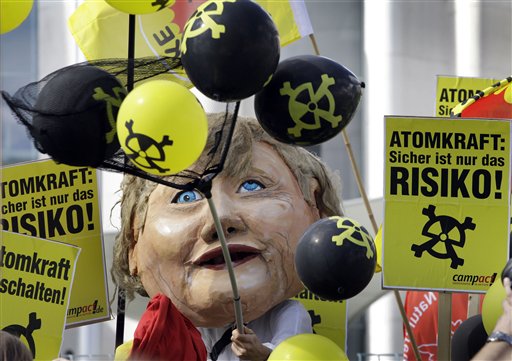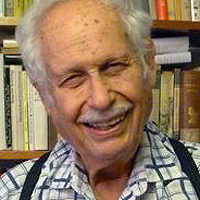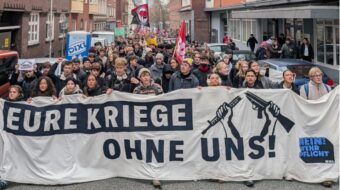
German Chancellor Angela Merkel always seems to smile when she faces a camera. Only once in a while does an unnoticed camera show her looking tired, if not worn and slightly haggard.
Things are not all going her way. More and more people are moving in Germany, mostly in the wrong direction, at least for Merkel.
In the center of Berlin last weekend over 100,000 people demonstrated against her government’s deal with giant atomic energy corporations. In a meeting with industry leaders she had smiled sweetly while agreeing completely to keep the 17 atomic power plants operating for an additional 12 to 15 years, meaning until 2040 at the earliest, while the extra taxes earlier demanded of the companies, proposed as a balance against harsh cuts in support for the jobless, poorer parents and senior citizens, would now be reduced to a minimum.
Angela had not only caved in completely, she had totally ignored and embarrassed young Ecology Minister Norbert Ruettgen, from her own party, who had promised there would be no such far-reaching deals. He had lost out to Economics Minister Rainer Bruederle from the coalition partner, the Free Democrats, who cared less about public opinion. His party has lost so much sympathy through its utter disregard for all but the wealthy that current polls give it hardly even the 5 percent needed to enter the next Bundestag. But that election is not due until 2013.
Although there have been many flukes and mishaps in older atomic plants in recent years, mostly unreported as long as possible, and the mine where radioactive remains are stored is far from secure, most media dwelled instead on possible job losses if the atomic plants are shut down sooner. The name Chernobyl was carefully avoided. But not in the huge demonstrations on September 18!
There were two smaller gatherings in Berlin that day. Two hundred neo-Nazis from the NPD party (National Democratic Party of Germany) held a rally, far from downtown, with music and anti-foreigner tirades. They were outnumbered as usual by 500 antifascists but protected by police. Also outnumbered by 800 opponents was a march of very religious anti-abortion ladies. Somehow many of their white crosses landed in the Spree River in downtown Berlin, but luckily there was no violence. Abortion is possible in Germany, though with a number of conditions and costs borrowed from the laws of West Germany (abortion was legal and free in Eastern Germany).
Far from Berlin, in the southwestern city of Stuttgart, angry demonstrations have been going on for months every Monday and every weekend in a very different matter. The city, the state of Baden-Wurttemberg and the nationally owned, independently run railroad system had decided to tear down Stuttgart’s central station, one of the few central buildings to survive the war, and replace it with a subterranean station adapted to high-speed connections with other parts of Germany and Europe. But a large number of Stuttgart people decided they liked their old station. They didn’t want it to disappear while 250 acres where it had been would be largely filled with modern office buildings. Three hundred handsome old beeches and other trees, some over 200 years old, would have go. The cost, officially 7 billion euros, would in the end probably top 10-18 billion. How many other more needed projects could be paid for with such a sum!
The demonstrations grew larger: 15,000, 25.000, possibly up to 70,000, week for week. People climbed the trees and the cranes, refusing to give in even after one station wing was demolished. Preachers preached, some prayed or sang “We Shall Overcome.” Others blew whistles or even vuvuzelas. A local artist became moral leader by common agreement.
At first the Christian Democratic mayor and the state government, a coalition of Christian Democrats and Free Democrats, refused even to meet the protesters, but as the weeks wore on and the demonstrations did not decrease the officials began to weaken, though sticking to impossible conditions. The matter is still undecided. The Social Democrats, who originally supported the plans, have been trying to extricate themselves from them. Like the others they are thinking of the state elections on March 4. The tree-saving Greens are in the strongest political position.
Very many Germans, like Americans, are enraged about banks which were bailed out with taxpayers’ money and, also like in the USA, are shamelessly reverting to former methods, even big bonuses. This does not make the government more popular. Nor do its plans to raise appreciably the amount people must pay for medical coverage. The slick minister of health, with a smile worthy of his boss, Merkel, camouflages his plans under many fancy words. But they all add up to higher payments for working people, and less for the wealthy.
Both the Social Democrats (SPD) and the Greens are profiting from all this. The SPD is slowly regaining the ground it lost so disastrously in last year’s elections while the Greens have climbed into a position where they might be the Number 1 party in the city-state of Berlin and head a coalition government there after elections next year.
With the help of the media, now occasionally more critical of the government, the past record of the SPD and Greens is forgotten. It was they, when they ran the government, who initiated many cuts in living standards, who raised the pension age to 67, cut help for the jobless, increased sales taxes for average consumers but cut taxes for the wealthy and the corporations. Even their time limits for atomic energy power plants, now to be dropped, were a weak compromise. It was while Social Democrats and Greens were in charge that construction of many such plants began.
This should be a time for the Left Party to grow rapidly; it is the only Bundestag party with a clean record on economic issues, on military spending, foreign adventures in Afghanistan as well as atomic power. Sadly, it has been occupied in recent months with internal worries. Its presence in the demonstrations on atomic power and the Stuttgart railroad station was hardly visible, while the media does what it can to downplay the Left’s spokespersons. The party has been debating questions like the need to change the social system, the pros and cons of joining government coalitions and participation in future UN military actions. These are important, no doubt, but hardly the issues able to bring lots of people out in the streets again, like those in France or Greece. Those who support the Left can only hope it will get its act together and start fighting on issues urgent to people here and now.
The importance of such struggles is underlined by the menace of a possible new party on the right, appealing to nationalism, feelings against immigrants, Islamophobia. This danger is growing everywhere, from tea party shouters in Nevada or Delaware to some boroughs of Berlin and to cities in Holland, England and now Sweden, where such a new party has had marked success. Recent discussions in Germany fostered by most media in connection with the banker Thilo Sarrazin and his anti-Turkish, anti-Arab racism, also statements by the head of an organization claiming to represent Germans thrown out of Poland and other eastern countries after World War II, have found a frightening resonance, even among some top men in the SPD (the party Sarrazin still belongs to, despite plans to throw him out). An estimated 10 to 20 percent might be reached by such demagogues, it is estimated.
The dangers are great, but democratic-minded Germans have shown a willingness to fight back. The right issues and the right paths must urgently be scouted out.
Photo: A protester, wearing a giant mask depicting German Chancellor Angela Merkel, tries to catch “atomic balloons” during a Berlin demonstration against the extending of nuclear power plants operating time, Sept. 5. Posters read: “Nuclear power: the only sure thing is the risk.” (AP/Michael Sohn)










